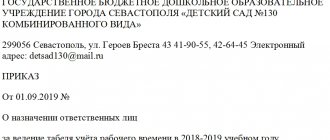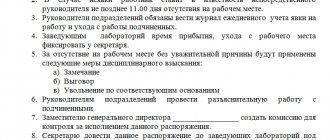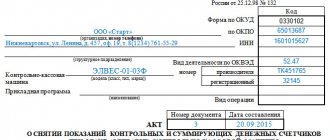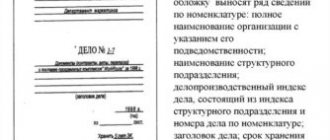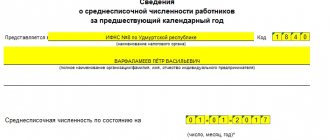THREE TYPES OF ORDERS
Our dictionary
An order is a legal act adopted by the head of an organization, acting alone, in order to regulate the activities of the organization[1].
Perhaps, of all the possible administrative documents of an organization, the order is used most often. Most of the manager's decisions are formalized by him.
Orders are divided into three types in only one regulatory document on office work - in the List of standard administrative archival documents generated in the process of activities of state bodies, local governments and organizations, indicating storage periods (approved by order of the Ministry of Culture of Russia dated August 25, 2010 No. 558, in as amended on February 16, 2016, hereinafter referred to as the 2010 List). We list the types of orders with storage periods (Table):
Table
Types of orders with storage periods according to the 2010 List
| Type of order | Shelf life | Note |
| By main (core) activity | Constantly | For organizations that are not sources of acquisition of state (municipal) archives, the period of storage of documents “Permanently” cannot be less than 10 years. This is indicated by a footnote to column 3 of the 2010 List |
| By personnel | 75 years if the order was created before 2003; 50 years if the order was created after January 1, 2003[2] | 5 years for orders: – about disciplinary sanctions; – annual paid holidays; – about leaves in connection with training; - about duty; – short-term domestic and foreign business trips |
| On administrative and economic issues |
It is not recommended to ignore the document storage periods established by the 2010 List. In accordance with the decision of the Supreme Arbitration Court of the Russian Federation dated February 21, 2012 No. 14589/11, they are mandatory for all organizations.
ORDER = ORDER?
Order – 1) a legal act issued individually by the head of a government body or organization in order to resolve operational issues;
2) the same as an order[3].
What “operational issues” are is not specified anywhere. In accordance with the 2010 List, the order is stored for the same periods as orders and is divided into the same types. In practice, in some organizations, the sole decisions of the director are formalized by instructions, rather than orders. This is acceptable.
How are PODs stored?
Despite the fact that the organization is obliged to store all PML, regardless of the statute of limitations, it is allowed to send for long-term storage those documents that there is no need to access in current activities.
The procedure in this case is quite simple:
- At the end of each calendar year, authorized employees assess whether it will be necessary to refer to the order or whether it has actually lost its relevance.
- All documents that have lost their validity are sent to a special storage facility or transferred to the archive.
- An information order on the main type of activity is drawn up about this fact, which is recorded in the journal as usual.
ORDER DETAILS
In accordance with GOST R 6.30-2003 “Unified documentation systems. Unified system of organizational and administrative documentation. Requirements for the preparation of documents,” regardless of the type, the order must contain a set of mandatory details.
A note about familiarization with the document is not a requisite according to GOST, but is required to be formalized in orders for personnel. The employee signs in the field provided for this purpose:
Or make a mark by hand:
The latter design option is more common since it is considered proof of familiarization.
If the organization operates an electronic document management system, employees are not familiarized with orders for core activities and AHD upon signature.
Acceptance of a task automatically means familiarization with it.
As for the design and structure of the text, there are differences depending on the type of order being created.
Order classifier
Order classifier structure
The order classifier is a systematic collection of generalizations of information that determines how individual types of orders are formed, signed, named, registered, how many and where they are stored. Having become familiar with the classifier, any employee of the company will be able to accurately determine by name and number in the future which division a specific administrative act belongs to, where it was registered, and also who stores the original document.
Typically, an order classifier contains several main categories:
- Document type. This includes the main category (by personnel, main activities, administrative and economic), as well as subcategories (if necessary, divide existing administrative acts).
- Index. Placed after the order number so that you can quickly determine what this document is about.
- Who performs the registration and storage of the document. A position is required if orders are stored and recorded in different locations.
- Shelf life.
- A brief description of the direction that governs the order assigned to this category (subcategory).
- Signature right. The position is introduced if the enterprise has delegation of authority between the first manager and his deputies (heads of structural units).
Remember, having a general classifier of orders, you can quickly train employees to navigate the administrative documents available at the enterprise and ensure normal office work.
ORDERS ON MAIN ACTIVITIES
Orders on core activities are designed to regulate the main activities of the organization. Their storage period is “permanent” or at least 10 years for organizations that are not sources of acquisition of state archives.
It is impossible to list the types of orders for core activities: it depends on the scope of the organization’s activities. However, we can distinguish categories of orders that are found in, perhaps, every organization. Let's list the categories and give examples of order headings.
•Approval, implementation, amendment of local regulations:
– “On approval of the Instructions for office work”;
– “On approval of the Nomenclature of Cases for 2021”;
– “On Amendments to the Internal Labor Regulations.”
•Creation, reorganization, liquidation and regulation of the activities of structural, separate divisions of the organization:
– “On the creation of the Office”;
– “On the liquidation of the “Western” and “Southern” branches and the creation of the “South-West” macro-region”;
– “On approval of the Archive Regulations.”
•Carrying out activities to resolve production issues:
– “On conducting an audit of office work”;
– “On conducting an examination of the value of documents”;
– “On approval of the Schedule for the acceptance and transfer of documents to the archive.”
•Resolution of operational issues related to the activity profile of structural divisions:
– “On the celebration of Labor Safety Day”;
– “On the development of an advertising campaign for a series of cosmetics “Morning in Scandinavia””;
- “On access of vehicles to the warehouse.”
And of course, the order on the main activity does not contain the distinctive features of orders on personnel and on administrative and economic issues, which we will discuss further.
Actions that change these documents
Activities of the enterprise itself
The order on the main activity includes issues related to the activities of the enterprise. They are developed by specialists. Such acts contain answers to the questions:
- what needs to be done;
- execution period;
- who is responsible for implementation.
The document contains:
- name “Order”, date and serial number;
- a heading revealing the subject of the order;
- main text, which may have separate paragraphs;
- responsible person;
- director's signature.
Salary
Such an act contains:
- Name of the organization;
- number, date;
- main text;
- director's signature;
- visa “agreed”;
- the worker’s signature confirming the acquaintance;
- O.
Important! Notice of a salary reduction is provided to the employee two months before execution.
The decision to increase the director’s salary is made by a meeting of shareholders or members of the company. Possible deduction from salary. Voluntary retention is possible for personal reasons. This happens forcibly when the debt to the company is no more than 20%, in some cases up to 70%. Indicated:
- company name, address;
- name of the act;
- number;
- main text indicating the employee, amount and basis for deduction;
- signatures of the director and accountant;
- employee signature with transcript;
- document date.
You can find out about the order to withhold wages here, and how to issue an order to change the salary, read here.
Personnel punishment
Within a month from the moment of recording a labor violation, punishment may be applied. The order includes the fact of violation, documents that are the basis for the act, type of punishment, full name. employee, his position. The worker must be familiarized with it within three days and signed.
Daily regime
The introduction of part-time work is allowed. If this is discussed during the interview, it is stated in the employment agreement. The manager issues an order on part-time working hours. If something like this is proposed by the director, then it cannot last more than six months.
If the duration of work is reduced, an order is issued explaining the motive and the period of validity of the regime. Employees are notified of this 2 months in advance. If they do not agree, their employment agreement may end.
You will learn more about completing an order to establish part-time work in this article.
Approval and change of staffing
The order indicates the name and location of the company, the number and signature of the director. The central part opens with the words “I approve this staffing table” with a description of information about workers and salaries.
Changes are possible 3 months before the activation of the next act. When introducing a new position, the order indicates its name, salary and start date. When a position or its name is reorganized, the worker with whom the new agreement is concluded should be notified.
Important ! If there is a downward change in salary, employees must be notified 2 months in advance.
If the employee does not agree, he is offered another job or the agreement with him is terminated. When vacant positions are eliminated, a document is issued on the abolition of vacant positions from a certain calendar date.
More information about the order to amend the staffing table can be found here.
Reduction in headcount
This order contains the name of the company, number, date, basis, number of people to be laid off or a list of positions to be laid off, and the signature of the director. It is prepared two months before the approximate date of reduction.
You can learn more about the order to reduce the number of staff here.
Cancellation of cash limit
You should indicate the number, basis, volume of the limit for the year, as well as responsible persons. You can issue an act waiving the limit. It will need to note that the organization does not fix the new limit.
Read more about the order to cancel the cash register limit here.
Referral to training
The order must contain:
number and date;- FULL NAME. and the position of the employee sent to practice;
- duration of the educational process;
- name of the educational organization;
- basis of training;
- amount of compensation (travel, accommodation);
- responsible person;
- employee signature;
- signatures of the director and responsible person.
For information on how to correctly draw up an order for referral to training, read this material.
ORDERS ON ADMINISTRATIVE AND ECONOMIC ACTIVITIES
- What is AHV? It is difficult to say what is included in the range of “administrative and economic issues”. The 2010 List comes to the rescue again, namely section 10 “Administrative and economic issues”, which consists of subsections:
•compliance with internal business rules;
•operation of buildings and premises;
•transport services, internal communications;
•ensuring the security of the organization.
Thus, orders of the organization devoted to the above issues will be considered orders under AHD with a shelf life of 5 years. Apart from the 2010 List, there is nothing to be guided by: there is no other normative or methodological document on office work that would contain a list of administrative and economic issues.
If orders on personnel are quite easy to separate from the rest, then with orders on administrative and economic issues difficulties often arise. Many secretaries solve the problem radically: they simply do not separate these orders into separate proceedings and classify everything that is not related to personnel as their main activity. This approach, at least, eliminates error and untimely destruction of an order for the main activity that is incorrectly assigned to ACD. If there are not many orders in the organization and it is decided to store them for only 10 years (because the organization is not the source of the state archive), then this method has a right to exist.
Judging by the list of administrative and economic issues given in section 10 of the 2010 List, there are many situations in which an order on AHD is issued. So, orders on AHD can be:
•order on the admission of workers/equipment to the organization’s facilities (Example 3);
•on determining a smoking area;
•on the transition to an electronic access system;
•repair of premises;
•on organizing the purchase of furniture, office equipment, household goods, office supplies;
•organizing the transportation of furniture, office equipment, documents when moving;
•organization of cleaning services (comprehensive or one-time);
•on assigning vehicles to drivers and officials;
•allocation of vehicles to solve various problems;
•allocation of corporate telephone numbers to employees, setting a call limit;
•conducting briefings on civil defense and emergency situations;
•on the protection of objects, etc.
It is impossible to provide an exhaustive list, as is the case with orders for personnel.
- AHD or not? Let's use a cheat sheet. Example 3 shows a common situation:
Let’s “run” this order according to four mandatory criteria (see sidebar “How to determine an order using AHD: cheat sheet”):
1) relates to the administrative and economic issue “Compliance with internal business rules” (section 10.1 of the 2010 List);
2) does not approve or make changes to the organization’s LNA;
3) does not contain solutions for personnel management. Yes, it lists the employees who will come during non-working hours, but going to work on Saturday was issued by a separate order for personnel, indicating remuneration and each person’s personally written consent. Our order simply lists the names of employees who must pass through the checkpoint. Under what conditions they do this is not the concern of the head of the security service;
4) does not contain personal data. Position and full name security chiefs are present in the text of the order for the sole purpose of indicating the employee to whom the task is entrusted.
Thus, the order relates to ASD (ensuring the security of the organization) and is one-time. “Constantly”[6], and especially for 50 years in the archive, he has nothing to do.
Purpose and classification of orders
From the name it follows that these orders are related to the main one, i.e. current activities of the company. They are defined as all those documents that remain after sifting out such types as:
- Personnel orders are all internal documentation that is related to the reflection of labor relations with both each employee and the team as a whole. PLS includes regulatory documents of the company regulating:
- hiring and dismissal from work;
- bonuses;
- collections;
- disciplinary penalties;
- sending on current and unscheduled leave;
- business trips, etc.
- Orders regulating relations in the field of administrative and economic activities of the company (PAD). This includes documents that contain instructions on the use of company property, material support, security of the facility - i.e. all tasks related to the material side of work and management of the company.
Thus, orders relating to the main activities of the company (POD) contain the most diverse group of documents, which in turn is divided into 8 subgroups:
- Structural – they relate to the regulation of the internal hierarchy in the company, its structure as a single system. Basically, such documents regulate the formation and termination of the work of branches, separate divisions, the creation and liquidation of new departments or separate groups within existing departments. This group also includes orders in connection with the acquisition of smaller companies by a company or in connection with a merger with larger companies. Thus, if a legal entity has a small number of full-time employees and does not have its own branches, then its structural activities are practically absent.
- Regulatory - in fact, these are all internal documents that have a regulatory nature: the internal legislation of the company. It is here that the working hours, daily routine, grounds for bonuses, principles of remuneration, instructions for each specific employee, etc. are prescribed. In this regard, they should not be confused with the PLC: for example, the provision on bonuses itself is a PLC, and the order for a bonus for a specific employee is a PLC.
- Organizational ones are close to normative ones, but they do not contain the company’s operating standards themselves, but describe specific tasks that individual employees, departments or the entire staff are facing at the moment. For example, management announces the transition to a shift work schedule for an entire department, introduces a new staffing schedule, or announces the creation of a commission that will investigate an accident, etc.
- Supervisors regulate regular scheduled or unscheduled inspections aimed at monitoring the work of a department or the entire company, as well as conducting re-certification, submitting annual financial statements, organizing inventory, etc.
- Reporting documents are a very important subgroup of AML: these are the documents that the inspection authorities are primarily interested in. This category includes all types of reporting - not only financial and economic in nature (accounting), but analytical reports, reports on the implementation of plans by departments with applications explaining the plan for a similar period in the future, as well as statistical reports (at large enterprises).
- Financial orders are not accounting documents, but those orders that outline a financial strategy, sales plans for the foreseeable future period, analysis of financial development risks in the niche where the company is located, etc. Those. this includes all documents that describe management's financial plans for a specific period.
- Security orders are all documents that relate to issues of material supply for the company’s activities: from the purchase of consumables to the acquisition of necessary raw materials, office equipment, etc.
- Information is the most diverse subgroup, which essentially includes all documents not included in the previous 7 groups. Usually these are regulatory orders regulating the registration of document flow, placement of a file in an archive, features of the preparation of internal papers, etc.
Thus, orders regulating the main activities of the company are a group of documents that are conditionally combined into one category. The selection is based on the “by contradiction” method - everything that is not included in the PLS and PAD is considered to be AML. The most common documents in this category that are found in any company are the following:
- on the establishment of a staffing table, its adjustment or complete change;
- on the introduction of work procedures for each employee: mode, working hours, number of shifts, time for a regulated break, etc.;
- on the implementation of any local act in the company, for example, labor safety rules at a particular facility, regulations on bonuses, etc.;
- on the inventory of all property assets of the company with the establishment of the procedure for conducting the inventory, a complete list of items with numbers, etc.;
- on the implementation of the current vacation schedule for each employee;
- on the procedure for the work of the commission organized to investigate the circumstances of the accident.
Orders for main types of activities are stored in the organization indefinitely, while for personnel, as well as administrative and economic orders - for 5 years. Therefore, it is better not to mix different issues in the contents of one document - then you will have to store too many virtually unnecessary papers.
FEATURES OF DESIGN OF TEXTS OF ORDERS
- The text of the order consists of two parts. The text of the order, unless the document is drawn up according to the form approved by the State Statistics Committee, always has a clear structure. It is divided into two parts: ascertaining and administrative. The parts are separated from each other by the word “I ORDER” (see Examples 2 and 3).
- Management decisions in the order are numbered. If the decisions are drawn up as a bulleted list, then it will be impossible to refer to any of the points of the administrative document in this case. There are simply no points. There are dots, check marks, or other symbols, depending on what the secretary likes. And it’s quite difficult to refer to the point. For comparison, here are two options for designing the administrative part of the order text:
- The text of the order is presented in the first person. Secretaries are often embarrassed by the need to formulate the management decision of the manager in the first person and use phrases such as: “I ORDER”, “prepare a project and submit it to me for approval”, “I leave control to myself”, etc. However, this is exactly how an administrative document issued under conditions of unity of command should be drawn up. Despite the fact that the author of the text of the order is almost always an ordinary employee of the organization, the document is issued on behalf of the manager, hence the grammatical form of the first person singular.
How to properly prepare a document: step-by-step instructions
An example of such a document is shown in the figure.
The structure of the order, regardless of the type of main activity of the company it regulates, is the same:
- Full name of the organization - here you need to indicate not only the abbreviation, but also the original name. All details, contacts and other information about the company should not be written down, since the order is intended only for internal use in the company.
- Name, i.e. the “Order” itself. It is better to make all letters in capitals and place them in the middle - as in most similar documents.
- Document details, i.e. date of publication/entry into force (sometimes these are different days), number (according to the uniform rules of internal numbering), place of publication (this is relevant for large companies that have local structural divisions and branches). Next to the document number you can put the designation OD, which classifies the order as regulating the main activity. This is not necessary, although for convenience it is recommended that you always label each paper accordingly.
- The actual topic of the order, which simultaneously serves as the main heading that precedes the entire text.
- Grounds for introducing an amendment or a new norm: “In connection with optimization”, “In pursuance of an order” (i.e. a reference to a decision of a higher management body of the company or a specific official), “In order to bring the system or individual elements into compliance with GOST (or other regulatory document)”, “Due to production necessity”, etc.
- The word "I ORDER".
- The actual description of the order and the identification of responsible persons (names and positions) for its execution. There are also cases when there are no specific people responsible, since the change is quite large-scale and affects the entire team as a whole. Then it is written that the director himself retains control of execution.
- Full name, signature of the authorized person. Here it should be noted that the organization’s seal is not placed on the order - this is an internal document, therefore one signature is considered sufficient that it was actually issued officially on behalf of the company. Those. an order for the main type of activity is valid only on the basis of the director’s signature.
Thus, in essence, such an order consists of all sections typical for this type of document:
- Details, company name (introductory part).
- The stating (descriptive) part, which contains the title (i.e. which side of the relationship the order regulates) and the basis for introducing the innovation: “For the purpose of improvement...”.
- Actually the administrative part, which follows after the word “I ORDER”. This is where the innovations, the deadline for their implementation and the officials who are responsible for the implementation of the idea are described.
- Attachments - if necessary, move large information - nomenclature, lists of names, other large blocks beyond the text of the order. All attachments are numbered (if there are several of them) and are an integral part of the order.
Reverse side of the document
Any AML, regardless of its purpose, has a downside; It lists the positions and names of employees:
- With whom the document revision was agreed upon.
- Which must be familiarized with it under signature.
- Who drew up the order itself. In large companies, the general director cannot even physically familiarize himself with, much less develop, the entire flow of documents that the company needs. Therefore, he delegates part of his powers to a trusted person - another employee. Most often this is a substitute.
Responsible persons for execution
In the case of using the Order Book, the management of the organization appoints a person responsible for its maintenance, registration, storage and filing. In general, this person is an employee of the HR department. If the Journal is kept in a small company, then the responsible employee may be an accountant.
The person responsible for maintaining the document should be indicated in the internal regulatory document (in the Personnel Record Procedure). It is advisable to indicate not the full name of a specific employee, but the position, because in this case, when the employee is dismissed, his duties will pass to his successor.
Common mistakes when creating an order journal
Below we will look at the TOP 3 common mistakes made when maintaining the Order Log.
Mistake #1. The procedure for maintaining the Order Log is not fixed by internal regulations.
As described above, the decision to use the Journal to optimize document flow is made by a specific company separately, depending on the situation and need. If the enterprise has decided on the need to maintain a Logbook for registering orders, then the procedure for entering information into the Journal must be fixed in an internal act (For example, in the Personnel Record Procedure).
What is an order and what does it look like?
An order is an official order from the manager or those authorized to issue a document, which is mandatory for execution by all subordinates.
The difficulty of drawing up this form is that all the points need to be clearly stated in it: deadlines, responsible persons, and if this is not done, which is what domestic managers often do, then there can be no demand.
Important! Such a document must clearly indicate what should be done, to whom, in what time frame, the task must be specified, and the resources for its implementation must also be described. If this is not the case, then it is not possible to punish for non-compliance.
There are several types of orders, including:
- administrative and economic;
- main activities affecting the main activities of any production;
- by personnel: hiring of workers, dismissals, vacations, business trips, etc.
Sample order log
In August 2021, Globus LLC issued the following orders:
- 08.17 – about the creation of a new product line;
- 08.17 – on changes to the staffing table;
- 08.17 – about organizational work related to moving to a new office.
Orders are numbered in accordance with internal order. The order log is formatted as follows:
| No. | Document date | Document Number | Contents of the document | Responsible for execution | For information |
| 48 | 03.08.17 | 84-OD | About the release of a new product line | Head of the production department Lubyanoy N.S. | Employees of the production and sales departments |
| 49 | 12.08.17 | 85-LS | About changes to the staffing table | Head of the HR Department G.D. Kukushkina | All employees |
| 50 | 22.08.17 | 86-AHD | About organizational work related to moving to a new office. | Head of the economic department V.D. Polenov | Housekeeping Department Employees |
Examples of common types of orders in 2021
The following are examples of the most common types of AML, which make up the main share in the document flow of almost every company.
- On assuming the position of a director (general director, head of a branch, etc.).
- On approval of the staffing table (introduction of a new one, amendments to the old one, establishment for the first time).
- On the transfer of functions (using the example of an employee performing personnel records).
- On the establishment, amendments or introduction of a new edition of the document “Internal Labor Regulations”.
- About the company's work schedule during certain periods (for example, during the May holidays).
- On the regulations for the actions of all employees in the event of a fire.
- About the smoking ban.
- On the appointment of a person in charge (using the example of a person responsible for fire safety).
- On the transfer of the right to sign (using the example of the right to sign in all personnel documents).
- On early termination of duties by the manager.
Content
First of all, indicate the name of the document, that is, “Order” in the center of the sheet. Further, before presenting the text, the topic, that is, what the order is about, the date of its preparation and the document number, in accordance with the registration book.
Next, the reasons are indicated, that is, the reason that led to the need to publish this document. Commonly accepted formulations:
- According …
- In order to…
- Due to...
- For the purpose of execution...
There may also be a link to a normative act, a previously issued decision, a clause of the charter, etc. This part ends with the resolution “I order.”
After this word, the administrative part begins; here it is very important to clearly, specifically and concisely indicate the essence of further actions and the persons who are responsible for carrying out the instructions.
Important! If the order has a deadline, then it is in the administrative part that they need to be indicated. If it is regular, no deadlines are specified. The final details are a signature with a transcript and the title of the position.
Mailing list
It is often required that employees familiarize themselves with the order, especially if it concerns organizational activities or personnel. In this case, a mailing list is created. It contains the following data:
- Briefly the essence.
- The persons who must familiarize themselves with the document are listed.
In some cases, such a sheet is not created, often in small enterprises, when it is physically possible to inform everyone personally.
Drawing up and processing of orders
Management specialists believe that 75% of the efficiency of an enterprise depends on formalized administration, i.e., on the ability to competently draw up instructions, orders and monitor their implementation.
In order for an order to be effective, it must contain at least three main elements for each item of the order, namely: what needs to be done, in what time and which employee is responsible for it.
Most managers do not adhere to these truisms, so orders often lack either a deadline or a performer. In one travel company, an order was displayed for employees and clients to see: “To improve customer service, we order that all stages be carried out efficiently.” The head of another company, having visited abroad, decided to introduce rules of dress at work in accordance with Western standards. The order signed by him sounded like this: “To improve the work culture, I oblige all employees to adhere to the corporate dress code.” But this demand of the leader remained unanswered. Firstly, no one explained to the employees what the manager considered “corporate clothing style.” Secondly, the order does not specify the timing of the transition to this style and the responsible person monitoring implementation.
There are three types of orders:
- order on administrative and economic issues;
- order on the main activity;
- personnel order.
Order on main activities
Let's consider the methodology for drawing up an order for the main activity.
Orders for core activities are legal regulations that implement the controllability of objects from top to bottom, that is, from the governing body to the managed one.
Preparation of an order includes several stages:
- initiation of the issuance of an order;
- collecting the necessary information;
- preparation of a draft document;
- coordination;
- checking the correctness of registration;
- signing;
- bringing the order to the executors.
The processing of administrative documents may be regulated by the regulations on the procedure for the preparation and entry into force of the organization’s administrative documents or by the introduction of a corresponding section in the organization’s office management instructions.
The text of the order consists of two interconnected parts: stating and administrative. The ascertaining part indicates the reasons that served as the basis for issuing the order. Typically, this part begins with the following stable phrases: “For the purpose of...”, “On the basis of...”, “In connection with...”.
If the basis for issuing an order is any normative act of a higher body, then the ascertaining part should indicate the type of act, its author, full name (heading), number and date, i.e. all search data should be provided. If there is no need to provide explanations, then the stating part may be missing.
The administrative part is separated from the stating part by the verb “I order”, which is written in capital letters on a new line, without a paragraph or quotation marks, and a colon is placed at the end of the verb. The administrative part is divided into paragraphs and subparagraphs, which are numbered in Arabic numerals. Each paragraph of the administrative part indicates the performer, the prescribed action and the deadline for execution. Performers can be either individual officials or organizations. The number of performers for each item is not limited. The performer is indicated in the dative case. For example: “To the Directors, Head of the Human Resources Department, Ivanov V.P...”, etc. The prescribed action is expressed by verbs in the indefinite form “prepare”, “enroll”, “provide”, “approve”. The deadline must be realistic and correspond to the scope of the proposed work. Typically, a separate deadline is set for each task. The last paragraph in the orders indicates the person who is entrusted with control over the execution of the document (position and full name). Administrative documents may have attachments, which are referenced in the relevant paragraphs of the administrative part. However, the “application” attribute is not issued in this case; links to applications are given in parentheses in the appropriate paragraphs. For example: “Approve the instructions for office work” (Appendix 1).
On the application itself, in the upper right corner of the first sheet, the word “Appendix” is printed (if there are several applications, they are numbered) and it is indicated which order or point of the order the application relates to, for example:
Dictionary of personnel records management. An order is a legal act issued by the head of a management body acting on the basis of unity of command to ensure basic and operational activities.
Appendix to the order - materials of a reference, documentary or other nature, additional to the main text of the order.
If the appendix to the order is an approved document (regulations, rules, instructions, etc.), an o is made in the corresponding paragraph of the administrative part, and the document approval stamp is placed on the appendix in the upper right corner.
In draft orders that have one or more appendices, there must be a single page numbering covering the main text and all appendices.
Attachments to draft orders must be endorsed by the executor who prepared them and by the heads of structural units. A mailing list is attached to the draft order.
The order is issued on a general A4 format form. Further, in the course of work on the draft order, the stages of coordination and signing follow. Draft orders prepared for approval are drawn up on standard sheets of paper with all the necessary details indicated and “Draft” indicated in the top field of the document on the right.
Before signing, the project is subject to agreement with all interested parties, as well as with the structural divisions and officials to whom it concerns. Coordination is carried out by approval. Visas or approval marks are usually affixed to the first copy of the project. In case of disagreement with the project, a reasoned conclusion is written. Before signing, the project is carefully checked for spelling or stylistic errors. The order is signed by the head or deputy head of the enterprise.
An example of drawing up an order with a corner location of the details.
To familiarize yourself with the order, extracts from the order for each item can be prepared.
An order for administrative and economic activities is drawn up in the same way as an order for the main activity.
Let's give another example of issuing an order for the main activity, affecting HR issues.
The employer must organize the correct and timely maintenance of work books, and responsibility for maintaining, storing, recording and issuing work books lies with a specially authorized person appointed by order (instruction) of the employer. The issuance of such an order for the main activity is mandatory, despite the fact that responsibilities for working with work books are always included in job descriptions and in employment contracts of employees responsible for working with work books. Due to the periodic change of personnel service employees, as well as their possible temporary absence, it seems undesirable to indicate in the text of the order appointing someone responsible for working with work books the surname of the currently working employee and you can limit yourself to the name of the position (if one staff unit is assigned to it).
Order on personnel
Orders on personnel constitute a separate group of personnel documentation and require certain drafting rules that differ from orders on main activities. They record hiring. relocation at work, dismissal from work, establishment of official salaries, vacations, business trips, change of name, incentives, penalties, etc.
Currently, unified forms of most orders for personnel are in force (Resolution of the State Statistics Committee of Russia dated January 5, 2004 N 1). They have peculiarities of drafting and execution: these orders are issued not for several actions, but for one, i.e., an order for employment is issued independently, an order for transfer, dismissal, or secondment is issued independently. Each order can be issued not for an individual employee, but for several at once, which is very convenient when there are a large number of employees.
The introduction of unified forms has caused a variety of opinions: some believe that such forms are convenient and necessary for the personnel service, others believe that the new forms increase the labor intensity of maintaining personnel documentation.
However, it should be taken into account that modern personnel documentation has such shortcomings as: the inability of some documents to be processed by means of electronic computers, an unjustified variety of forms that formalize similar tasks for organizing personnel management, and the absence of a single regulatory document for the preparation of personnel documentation.
The developers of unified forms of personnel documentation pursued two goals: to streamline and unify the traditional set of documents that formalize a number of tasks for organizing personnel management and to adapt these documents to computer processing.
The introduction of unified forms of orders for personnel made it possible to introduce uniformity into the structure of the text of the document and relieved personnel service employees from doubts about choosing one or another option for writing the administrative part.
Due to the fact that unified forms have not been developed for all orders for personnel, we will consider the general features of the execution of orders for personnel that are not included in the list of unified forms.
The execution of orders for personnel does not have clear GOST instructions for the execution of administrative documentation (GOST R 6.30-2003 “USD. USDORD. Requirements for the preparation of documents”), however, in order to introduce uniformity in the preparation of this type of document, it is necessary to adhere to a number of rules that are stipulated in instructions for organizing work with documents in a specific organization.
Orders for personnel are drawn up on A4 format and have the following details:
- name of the organization that authored the document;
- name of the document type - “Order”;
- date, number;
- place of publication, title to the text;
- text;
- signature;
- visa approval;
- a note confirming familiarization with the employee’s order;
- a note on the execution of the document and its sending to the file.
Orders are numbered within a calendar year. The number (index) is written with the letter “k”, which means an order for personnel, or l / s (order for personnel), other letter designations are possible. The main thing to remember is that orders with different retention periods cannot be formed into one case. Orders are usually endorsed by the Deputy Director for Human Resources, an employee of the HR department, or the head of the department to which the employee is sent, and orders that have a clause on financial liability must be endorsed by an accountant. The employee maintaining personnel documentation must familiarize each employee with the order, after which the employee affixes his visa, consisting of the following elements: “I have read the order,” signature, transcript of the signature and date of familiarization.
Orders come into force from the moment they are signed, but sometimes the text of the order may indicate a different date for its entry into legal force. For example, the order was signed on April 22, and the employee was appointed to the position on April 27.
The texts of the personnel order are subject to special requirements: the wording must be clear and precise, as they reflect the employee’s labor rights. An order on personnel, unlike an order on the main activity, may not contain a statement part and the administrative word “I order” (it is not contained in orders on personnel, unlike an order on the main activity). The command word in orders for personnel are the words: “Accept”, “Dismiss”, “Assign”, “Change”, “Assign”, etc.
The text of the order, in connection with established practice, can be drawn up in two ways.
The first option is when the administrative part usually begins with a verb: “Change”, “Assign”, “Announce”, etc., printed in capital letters without a paragraph on a new line after the title to the text. The heading to the text of the orders answers the question “about what?”: about hiring, about dismissal, about changing the last name, about reprimanding, about transferring to another job, etc. Then, on a new line, from a paragraph, the full last name and first name are written , patronymic of the employee to whom the order is issued and subject to the order.
Example:
Announce:
Ivanova Irina Sergeevna, senior expert of the sales department, reprimanded for
negligent attitude towards official duties resulting in damage
technical equipment.
In the second option, the administrative word is written on the same line with the action. Let's consider drawing up an order to amend documents containing the employee's personal data in connection with the employee's marriage. This order does not have a unified form and is drawn up according to the rules for drawing up administrative documents. The text of such an order must necessarily contain information about both the old and new data of the employee, and details of the documents on the basis of which new information about him is entered. The recommended name for such an order is “Order to amend documents containing the employee’s personal data.”
Sample order on amendments to documents containing personal data of an employee
It is not recommended to use a common formulation like “From such and such a date, consider Ivanova Lebedeva in connection with the registration of marriage...”, because this is illiterate. One might think that without an order from the employer, Ivanov would not be considered Lebedeva? She is considered Lebedeva on the basis of a marriage registration certificate, and not on the basis of an order from her employer.
Another common wording is also incorrect: “Make changes to the employee’s personal data.” Changing an employee’s personal data is the authority of special government bodies, and not the employer’s personnel service. The personnel service only makes changes to documents containing personal data on the basis of documents on changes in personal data of employees issued by special government bodies.
The date of the order is the receipt of a copy of the passport by the personnel service.
Registration and storage of orders
An order to amend documents containing personal data is registered in the appropriate order register.
The order to amend documents containing personal data is presented to all interested parties against signature: the employee himself, the relevant personnel and accounting employees.
Based on such an order, changes will be made to the employee’s work book, the employee’s personal card, the employee’s personal account and other documents of the personnel department, accounting, security service and other structural units.
Orders for core activities have a “permanent” shelf life. Orders on administrative and economic issues - storage period is 5 years.
Personnel orders on hiring, dismissal, and transfer of employees are stored for 75 years. However, orders on the provision of educational leave, duty, penalties, short-term business trips within Russia have a shelf life of 5 years in accordance with Art. 6 List of standard management documents generated in the activities of the organization, indicating storage periods. The orders in the case are arranged according to the serial numbers of the orders.
Bibliography
1. State system of documentation support for management (GSDOU). Main archive. 1991.
2. GOST R 6.30-2003. “USD. USORD. Documentation requirements." M.: Rosarkhiv; VNIIDAD, 2003.
3. Doronina L. A. Organization of document flow: Educational and methodological manual. M.: State University of Education, 2005.
4. List of standard management documents generated in the activities of the organization, indicating storage periods. M.: Rosarkhiv; VNIIDAD, 2002.
L. Doronina K. e. Sc., Associate Professor, Deputy Director of the Institute of Management Information Systems, State University of Management
Signed for publication on June 20, 2010 “Personnel Officer. Personnel records management", 2010, N 7
unified forms of orders for personnel order to change the surname of an employee sample storage periods for orders for personnel order for personnel sample form of orders for personnel book of registration of orders for the main activity numbering of orders at the enterprise forms of orders for the enterprise orders for personnel sample journal for registration of orders for the main activity, the shelf life of orders for personnel, how to draw up an order



